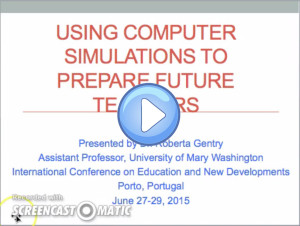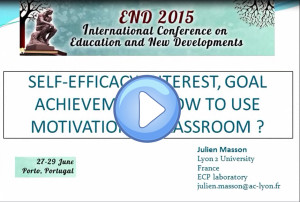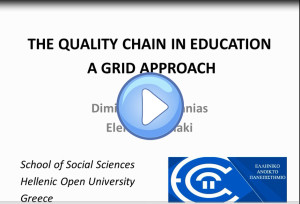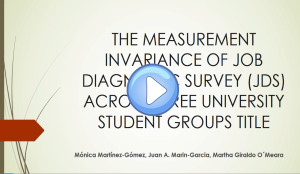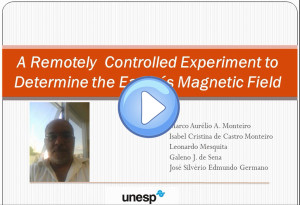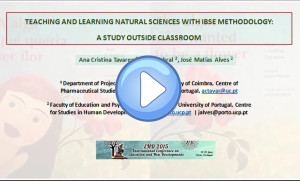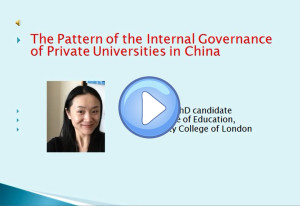Teachers and Students
Title: USING COMPUTER SIMULATIONS TO PREPARE FUTURE TEACHERS
Submission code: P_315
Author: Roberta Gentry
Abstract: Simulations may be used to introduce pre-service teachers to the complexities of teaching and also to bridge the theory to practice gap in education. Within simulations, professors can change the composition of the class to include a variety of ethnicities, cultural backgrounds, achievement levels, and also include students with disabilities to scaffold candidate’s learning. This also provides a model classroom for pre-service teachers to practice their skills and apply concepts learned in college courses to teaching scenarios. A brief literature review of the use of computer simulation in teacher education programs is presented and summarized including the advantages and disadvantages of using computer simulation in higher education. Finally, a pilot study in which computer simulations software was used with 12 initial licensure general education teacher candidates in an introductory to special education course will be shared. Candidates reflected on their experiences with using computer simulation. The instructor of the course will also share lessons learned.
Keywords: Simulations, simulated learning environments, teacher education.
File Extension: QuickTime Movie (.mov)
Title: SELF-EFFICACY, INTEREST, GOAL ACHIEVEMENT: HOW TO USE MOTIVATION IN CLASSROOM?
Submission code: P_463
Author: Julien Masson
Abstract: Motivation is a concept both found in the scientific literature and in everyday language and even more in school. Motivation is used to explain sometimes the success, sometimes the failure of the pupils. It is rather complicated to define motivation. Fenouillet has counted at least 101 theories about this subject. We’ve picked out three of them. They particularly work in primary school: – self-efficacy; – achievement goals; – interest; The purpose of the present research is to show in what extent pupils’ performance can be related to their inner motivation. Our study was first to develop psychometrically reliable measurement scales to apprehend self efficacy, achievement goals and interest for primary school pupils. After that, we measured their results to standardized tests in French and mathematics and calculated the correlations between these variables. Our sample consisted of 427 pupils from French primary school of 10.5 years average. The results are as follows: -Self-efficacy (especially in French) positively impacts school achievement. -Performance approach goal negatively impacts school achievement. -Learning approach goal has no impact on school achievement. -The two avoidance goals are not necessarily detrimental to academic achievement. -Interest is affected both by achievement goals and self-efficacy, but has only a small impact on school achievement.
Keywords: Motivation, self-efficacy, achievement goals, interest, primary school, school achievement.
File Extension: Windows Media Audio/Video file (.wmv)
Title: THE QUALITY CHAIN IN EDUCATION – A GRID APPROACH
Submission code: VP_279
Authors: Dimitrios A. Giannias & Eleni Sfakianaki
Abstract: Based on the concern for people and the concern for production, Blake and Mouton (1964a) presented the managerial grid model which explored five leadership styles. Ever since, the theory developed further to include more leadership styles and a new component; that of resilience. Blake and Mouton introduced the Sales Grid, an evaluative tool that is largely used in the sales sector. However in principle the managerial grid is potentially applicable to a variety of contexts such as sales, supervision, media, personal etc. In essence it is suitable to any human activity that involves at least two parties and the production-supply of a product or service. In practice the managerial model is illustrated as a grid with two axis – one representing the concern for the production and the other the concern for people. The present research investigates how this model can be applied in the quality chain of education using basic principles of total quality management. In this respect the parties involved in the educational quality chain are basically the teachers/professors and the pupils/students and the product/service is education. The aim ultimately is, to examine the potential for improving the educational quality chain but also provide personal improvement to all parties involved.
Keywords: Quality chain, education, total quality management, grid model, improvement.
File Extension: Windows Media Audio/Video file (.wmv)
Projects and Trends
Title: FROM SPORT EDUCATION TO INCLUSIVE TEACHING FOR THE IDENTIFICATION OF SEN
Submission code: VP_359
Authors: Laura Rio, Paola Damian & Filippo Gomez Paloma
Abstract: The theme of special educational needs (SEN) and, broadly, the question of diversity, is a central value for “innovative inclusive schools”, following the neurodiversity concept (Amstrong, 2011). International educational documents claimed the centrality of the development and life project of each person as the school’s mission, to be achieved within the community context. ICF (International Classification of Functioning, Disability and Health, WHO, 2001) considered the totality and complexity of the functioning of the person, recognizing the role of contextual factors (personal and environmental), as well as organic and structural aspects. Personal factors are not encoded in the ICF framework, even if they are very influential in the learning process. For this reason, we considered them as key elements on which to build our research model. This model reflected the Embodied Cognitive Science (Gomez Paloma, 2013; Caruana & Borghi, 2013), a paradigm which highlighted the significance of emotional, sensory and motoric dimensions in the individual, global development. Physical exercise improves brain structure and function (Chaddock et al, 2010); moreover, recent research (Ianes & Gomez Paloma, 2014) demonstrated that Sport Education activities provide an excellent assessment framework for the identification of SEN, because physical activity is an inclusive disciplinary area which allows students to express their personality, build relationships, express motor behaviours, etc. The aim of this research is to involve schools, giving them scientific criteria for the identification of SEN, and enable them to experience models of inclusive education within an action research process. Through EDUFIBES, a software produced and validated as a tool for the detection of personal factors helpful in the identification of students with special educational needs, it has been tested strategies for inclusive practices and collected input and output monitoring data. The data emerging by the software has been useful for the preparation of two types of courses – one for empowerment and the other for remediation – and for the preparation of a customized teaching plan, based on ICF, that considered the global dimension of the whole class, besides SEN student, and of their personal and contextual factors.
Keywords: Inclusion, Physical Education, Embodied Cognition.
File Extension: Video Clip (.avi)
Title: FOUR LEGGED TEACHERS. WHAT ABOUT ANIMAL AS TEACHER?
Submission code: VP_363
Authors: Alessia Gallo, Laura Rio & Filippo Gomez Paloma
Abstract: In the last years, we often hear about “pet therapy” or educational, rehabilitative and therapeutic process conducted with the interaction and the relationship between man and animal. The child psychologist Boris M. Levinson (1964) noticed that when his “canine co-therapist” was in sessions, his presence softened children’s defences and provided a focus for communication. In this project, we dealt with Animal Assisted Psychomotor Therapy (AAPT), which is based primarily on the area of movement for the recovery of the cognitive sphere and then the acquisition of motor patterns and autonomy (Piccinno, 1999). The purpose of this project was to try to overcome the simplistic conception that “animals are good for man” and turned it into a concrete operational proposal, above all by understanding how and how many facilities are available to follow this therapeutic program towards these new ways of learning. In order to understand whether this was well accepted in the educational programs in Salerno (Campania, Italy) schools, there were made structured interviews with multiple choice questions to parents and teachers to understand the degree of information received in the field of AAPT and their opinions about it. The interviews showed a variety of opinions: who already had the opportunity to interact with pets considered interesting to combine the AAPT to the teaching programs, others, instead, believed the proposal completely useless despite knowing the benefits of the method. In conclusion, the AAPT is still struggling to enter into the collective imagination as a concrete operational proposal to apply to schools because of lacking and superficial information, so more researches are needed.
Keywords: Pet therapy, Animal Assisted Psychomotor Therapy, Learning.
File Extension: Windows Media Audio/Video file (.wmv)
Title: HYBRIDIZING L2 LEARNING: INSIGHTS FROM AN INTACT CLASS EXPERIENCE
Submission code: VP_419
Authors: Nádia Silveira & Kyria Rebeca Finardi
Abstract: Based on the assumption that both knowledge of English and digital literacy are important tools to access information online (Finardi, Prebianca, & Momm, 2013), the present study investigated the impact of a hybrid approach to English as a foreign language teaching in an intact class in Brazil. Hybrid approaches have been described as the combination of face-to-face classes with online instruction, which may be implemented at the activity, course, program or institutional level (Graham, 2005), and in this study it was operationalized as the combination of face-to face classes with computer-mediated activities performed in an online environment. Twenty male participants were recruited in an intact class in the Brazilian Navy Academy Boarding School to participate in the study. Data includes class observation, tests, questionnaires and interviews, analyzed qualitatively to evaluate the impact of online tasks in L2 learning, as well as in the development of students’ autonomy and digital literacy. Three tasks adapted from Finardi and Porcino (2013) using different sites on the internet were administered, followed by a questionnaire after each task. Overall results of the qualitative analysis of students’ perceptions of the tasks performed in the online environment revealed that the L2 hybrid approach used may contribute to the development of students’ autonomy, motivation, digital literacy and L2 development through extended contact with and in the target language.
Keywords: L2 teaching, Hybrid approach, L2 Tasks, Internet tools.
File Extension: Windows Media Audio/Video file (.wmv)
Title: THE MEASUREMENT INVARIANCE OF JOB DIAGNOSTIC SURVEY (JDS) ACROSS THREE UNIVERSITY STUDENT GROUPS TITLE
Submission code: VP_444
Authors: Mónica Martínez-Gómez, Juan A. Marin-Garcia & Martha Giraldo O’Meara
Abstract: Equivalence of measurement across different samples is a prerequisite for the generalization of an instrument. This study addresses the equivalence of the adapted version of the Job Diagnosis Survey (JDS) as a measurement tool and as a quality indicator of the teaching methodologies at a Spanish public university in three different contexts according to the degree and academic year. The study compared data collected from three degrees programmes, using a validated model that analyses the relationship between the features of teaching methodology with university students’ motivation and satisfaction. A confirmatory factor analysis was carried out using a multigroup structural equation models, using the program EQS 6.1 to test the invariance. The assessment of invariance included the levels of configural, metric, scalar, covariance and latent variables invariance. Several goodness-of-fit measures were assessed. The results show that measurements are equivalent at the configural, metric, covariance and latent factors invariance. Although the hypotheses of scalar invariance is rejected, results suggest that JDS is partial strict invariant (equality of factor patterns, loadings and intercepts across time for all items and equality of item uniqueness) and has satisfactory psychometric properties on all samples. So we can establish, with caution, that the factor structure of the proposed model is equivalent in all groups.
Keywords: Measurement equivalence, student´s satisfaction and motivation, job diagnosis survey, multigroup confirmatory analysis, higher education, invariance.
File Extension: MP4 Video (.mp4)
Title: WEB 2.0 TOOLS FOR THE L2 CLASS
Submission code: VP_476
Authors: Karina Antonia Fadini & Kyria Rebeca Finardi
Abstract: Based on the concept of ‘produsage’ (Bruns, 2008), the present study suggests ways to use and produce contents using web 2.0 tools for the teaching-learning of English as an additional language (L2). Finardi, Prebianca and Momm (2013) suggest that in the globalized world we live in, some knowledge of English and digital literacy are important skills to access information online. Finardi and Porcino (2014) reviewed the role of technology in L2 learning, concluding that internet has changed the way we use, learn and teach languages. Based on these assumptions, the present study aims at offering a review of internet tools to support, integrate and/or complement L2 classes teaching/learning/using. The tools reviewed and proposed may lead to creative productions in L2, as well as offer opportunities to use the language in contextualized manners. Another objective of the proposal is to enable L2 teachers/learners/users to develop their digital literacy defined as the ability to find, evaluate, utilize, share, and create content using information technologies and the internet (Casey & Bruce, 2010). Overall, five tools were reviewed – each one for a different teaching/learning/using purpose. Results of the analysis of tools reviewed in this study seek to contribute to the informed use of technology in L2 teaching/learning/using.
Keywords: Web 2.0 tools, L2 teaching-learning, digital literacy, produsage.
File Extension: Windows Media Audio/Video file (.wmv)
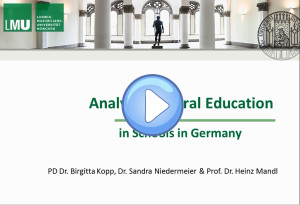 Title: ANALYZING MORAL EDUCATION IN SCHOOLS IN GERMANY
Title: ANALYZING MORAL EDUCATION IN SCHOOLS IN GERMANY
Submission code: VP_522
Authors: Birgitta Maria Kopp, Sandra Niedermeier & Heinz Mandl
Abstract: The main objective of this study is to introduce a model for analyzing moral education in institutions and to exemplify this model with data of projects fostering moral education in schools in Germany. Our model includes five levels, namely (1) objectives of practical moral education, (2) the macro-level of politics, society, and religion, (3) the meso-level of the single institutions, (4) the micro-level of interactions between human beings, (5) and the results of practical moral education. The presented model is exemplified by projects which were launched in schools in Germany in the years 2009 to 2014. We identified 51 school projects which were analyzed according to our model. Results show that using this model for analyzing moral education is an effective way to get a systematic overview of different projects. Even though objectives, meso-level and micro-level are reported, often, key issues for evaluating the effectiveness of the projects on moral education are missing.
Keywords: Model for analyzing, value education, institutions, schools.
File Extension: Windows Media Audio/Video file (.wmv)
Title: A REMOTELY CONTROLLED EXPERIMENT TO DETERMINE THE EARTH´S MAGNETIC FIELD
Submission code: VP_525
Authors: Marco Aurélio Alvarenga Monteiro, Isabel Cristina de Castro Monteiro, Leonardo Mesquita, Galeno José de Sena & José Silvério Edmundo Germano
Abstract: It has been pointed out in the literature that, besides the traditional classes, the teaching of scientific concepts should consider a variety of learning situations and teaching techniques, as, for instance, the use of experimentation. Laboratory practices favour, among other aspects, the contextualization of the theoretical concepts, linking them to real world phenomena. Unfortunately, in the context of the Brazilian public high schools (and even in the majority of the private ones), the Physics teacher very seldom has at his or her disposal a laboratory, ready and appropriate, which he or she can use to take advantage of experiments and demonstrations. Moreover, in Brazil usually the teachers are not well prepared to explore all benefits that an experimental activity could provide. In-service courses are not enough to fill the gap, due to both the high workload of the teachers, not being uncommon to find teachers who work at more than one school, and the usual lack of even a room for experimental activities in the schools. An alternative that has been offered to overcome the limitations of the lack of laboratory and experimental equipment in high schools is the use of remotely controlled laboratories. The Remote Laboratory, in general, offers access to equipment, countertops and real laboratory experiments via a computer connected to the Internet. Thus, a user can, through a computer with internet access, perform the experiment in a real way, remotely controlling the actions at a distance: adjusting the equipment and collecting data. Notice that this is not a simulation, but a real experience in which a web server allows the user, besides the control of the devices, to visualize both the equipment and the data from installed cameras, which transmit images in real time. In our work we comment about the results of a survey on remote experimentation, which was carried out considering works published from the year 2000 up to the year 2009, considering only “top-rated” journals (in accordance with a Brazilian standard of classification). According to the authors of the research, notwithstanding the importance of the remotely controlled laboratories as convenient teaching tools to deal with experimentation, they are little known and little used in Brazil, in special for experimental activities in Physics teaching. Works can be found in the literature discussing the benefits that such educational resource could offer for scientific teaching. We could mention, among others, the following possible contributions of the remotely controlled laboratories: the sharing of them among different institutions; their adaptability for students with special needs; the access from any location; and their use in teacher formation programs at a distance. As a concrete development of our group, working at the Center InovEE – Inovation Center for Energy Efficiency, located at the Sao Paulo State University (Campus of Guaratinguetá), we will present the conception and development of a prototype of an experiment, intended to address concepts related to electromagnetism in Physics classes.
Keywords: Electromagnetism, Physical Education, Remote Laboratory, WebLab.
File Extension: Windows Media Audio/Video file (.wmv)
Teaching and Learning
Title: TEACHING AND LEARNING NATURAL SCIENCES WITH IBSE METHODOLOGY: A STUDY OUTSIDE CLASSROOM
Submission code: VP_030
Authors: Ana Cristina Tavares, Ilídia Cabral & José Matias Alves
Abstract: Inquiry Based Science Education (IBSE) was recognized as an advantageous method in professional updating and improvement for .teachers and educators, through a training course on Natural Sciences educational practices outdoors, part of the Educative Program performed in University of Coimbra Botanic Garden[1]. IBSE lesson plans on plants main groups and their evolution were now applied to two samples of pupils from the 3rd and 5th grade of the basic level of education, with 81 and 89 cases, respectively, having been performed in an outside classroom environment, with direct contact with plants. The aim of this study is to directly contact, listen and question the students involved in the program, in order to understand the impacts of this methodology on Natural Sciences learning, using pre and post questionnaires as assessment tools, completed by students before and after the sessions, respectively. In addition to good indicators of evolution and enrichment of the knowledge and the skills of the students, their attitudes and final ideas and proposals revealed motivation and interest to increase the resources of the activity to extend its scope as well as their knowledge. [1]The Educative Program of Coimbra Botanic Garden (Tavares, 2011) contains more than thirty educational activities, especially dedicated to Schools, crossing the programmatic curricula of all grades. The actions are presented through an overview, objectives, target audience, topics and curriculum connections and skills to develop. In a final annex presents the teaching materials, content and produced resources such as materials, lesson plans, guides for educator / teacher and the student.
Keywords: IBSE, experimental methodologies, active learning, Natural Sciences, outdoors spaces.
File Extension: Windows Media Audio/Video file (.wmv)
Organizational Issues
Title: THE PATTERN OF THE INTERNAL GOVERNANCE OF PRIVATE UNIVERSITIES IN CHINA
Submission code: VP_295
Authors: Xu Liu
Abstract: The purpose of the present study is to explore whether and how private universities in China fulfil the expectations of the state and their other stakeholders, through an inquiry into their governance practices. It employs the multiple comparative cases study with 25 interviewees who are presidents, chair persons and members of council, experts and officers of the government in private university in China. In order to collaborate and corroborate the interview data, documentary analysis was used as well. This paper presents some findings from this study.
Keywords: Private universities, stakeholders, cases study, findings
File Extension: Windows Media Audio/Video file (.wmv)

